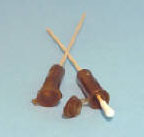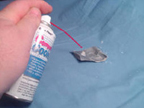|
|
|
CSI: Tools of the TradeViewers of CSI have grown accustomed to the abnormal and bizarre tools of the trade utilized by CSI agents in the shows, but many have wondered about the legitimacy of those tools in the real world of CSI.
Between Gil Grissom and his bugs, and Horatio Kane and his sunglasses, (that’s a joke by the way) – the shows collectively illustrate that criminal science is more then just fingerprints and microscopes. However, like all things Hollywood touches, the CSI show is a sensationalized copy of reality, and lines between fact and fiction are non-existent.
In real life CSI agents detect, collect, analyze and present evidence in a court of law. In the show, wielding guns and badges—CSI agents are the law.
Real forensic experts have complained about the embellishments on the show, specifically the unrealistic swiftness of the forensic examinations. But the tools of the trade are equally unrealistic.
One such example is the computer databases that the characters use to examine evidence like fingerprints that don’t actually exist in most CSI offices. Moreover, real life CSI investigators hardly leave the lab, and rarely do they ever interview criminal subjects.
But one must still give the show credit—because its popularity has not only increased college applications to forensic science programs, but has also shined a light on the hard work CSI investigators do in ensuring justice is carried out. So while the shows can be seen as a form of “science fiction”, they can also be viewed as an advertisement as to why Crime Scene Investigation is so important in solving crimes.
The CSI series are known for their detailed technical discussions. Anything ranging from bullet trajectories, blood spatter patterns, organ damage and of course most important of all: methods of gathering evidence are discussed on the shows.
In fact in the tumultuous world of real CSI, the tools of the trade are just as important as the person who is doing the investigating.
To begin with, CSI agents arrive at every crime scene with several different tools for measurement such as angle finders (they’re kind of like glorified protractors), measuring tape, thermometers and temperature probes.
As well, they carry various types of evidence markers. The environment of the crime scene determines what specific evidence marker the CSI agent will use. In general, evidence markers are fluorescent, because at night they reflect the flash of the camera
Which leads to the next stage, photography and portable light sources. Every crime scene must be properly photographed and lightened up in order for the agent or agents to do their job effectively.
The next process involves blood detection and dust lifting. And the show isn’t that far off the mark in these regards. The fact is CSI agents do know where to look for prints and spatters. They normally find the surfaces so easily due to good side lighting and the fact that after years of experience they’re good at what they do.
Any evidence gathered is packaged and sent to a lab and from there, the lab work begins. But that’s another story. For now, we’ll just focus on a few of the tools they use.
Hemastix:
Tests whether the substance you see is actually blood. The way it works is that it detects hemoglobin in a substance. It is easy to use. Hemastix will not detect the difference between human and animal blood.
Integri Swab:
Individually packaged swab, used to collect stain (blood) and to store it and allow it to breathe and dry evenly. The swab can be sealed and placed in a swab box, which is made out of cardboard letting it breathe-box is then sealed and the collection is complete.

Mity Loupe 7x Magnifier:
Focused on dual lenses, allows for the examination of objects close-up. Allows for measurement of bloodstain as well bloodstains can be photographed through the 7x magnifier with the scale for proper documentation.

Pathfinder:
A wireless electrostatic dust-lifting device used to do dust lifts off of most surfaces i.e. wooden, window ledges, carpet, tile, upholstery as well as surfaces that have conductive properties.
Stati-lifter:
Uses simple static electricity. It works on most surfaces with the exception of porous surfaces such as rough concrete and carpets.
Stun Gun Electrostatic Lifter:
Can detect and recover dust or non-visible wear tracks as well as latent prints in dust.
All it requires is using one stun gun, a sun blocking window film without adhesive and a probe with 2’ lead and alligator clip on the end.
reflective chalk, reflective string, component spray (used to compensate for working with fragile materials, it freezes the material) and of course latex gloves

